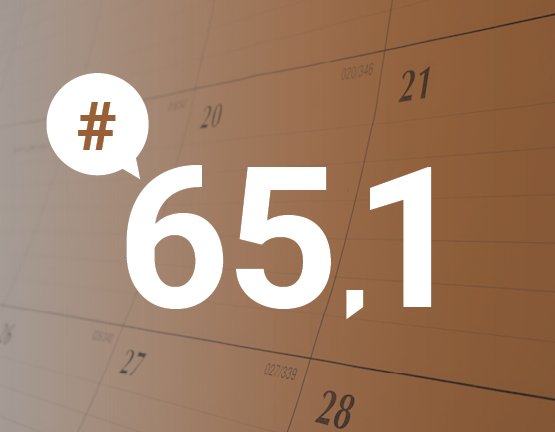- Keep an eye on passive income
If you own a small business, perhaps you retain a portion of your assets in your company to be invested in one way or another. However, the 2018 federal tax reform, which comes into force this year, will affect the income – known as “passive income” – that you receive from these investments. As shown in the following graph, any passive income above $50,000 will reduce the amount of your profit eligible for the small business deduction – otherwise known as the “small business tax rate.” This provision might encourage you to take a fresh look at your investments, your wages, your dividends and your business expenses.
- Financial markets: the year ends on December 27
While on the topic of investments, note that you only have until December 27 to make securities transactions for 2019 in Canada. Transactions made after that date will be attributed to 2020 since the settlement period for Canadian financial markets is two business days.
- Time to realize some gains… or losses?
You have until December 27, as well, to complete transactions that could generate a capital gain or loss, which might be more important now than it used to be, given the above-mentioned new rules affecting passive income.
- Watch out for year-end distributions
If you invest in mutual funds*, note that many of them distribute income to unitholders before the end of the year. If your investment is held outside a registered plan, this could generate a statement of investment income that you will have to declare on your next tax return, even if you have not sold your units. Note that this distribution takes effect whether you bought your funds years ago... or just last week.
- At 60, time to think about retiring?
If you are closing in on 60 or already there, one major decision in the near future could be to determine how quickly to withdraw funds from your RRSP and when to apply for your government pension benefits. There could be good reasons to cash out sooner and take your government pension later – or vice versa. With that in mind, this might be a good time to seek some professional advice, since your decisions could have an impact starting with your next tax bill.
- At 71, time to say goodbye to your RRSP
On the other hand, if you turned 71 in 2019, be aware that this is a pivot year for you. In fact, you have until December 31 to make one last contribution to your RRSP and, in addition, you must close out your RRSP before the year ends. You have two choices: either withdraw everything from your RRSP (which is not usually recommended since the whole amount would be taxable), or roll it over into a retirement income vehicle, such as a registered retirement income fund or an annuity.
- TFSA: $63,500 already
Given that the annual TFSA contribution room increased to $6,000 in 2019, anyone who was at least 18 years old when the plan was created in 2009 now has cumulative contribution room of $63,500. For everyone else, the total room available depends on the year you turned 18. As you know, the TFSA is a popular tax shelter where all accumulated gains and income remain tax free, even when withdrawn. However, the rules around withdrawals are not always well understood. If you are planning to make a withdrawal, it might be a good idea to do so before December 31. That way, you would free up an equivalent amount of contribution room as of 2020. If you wait until January, you wouldn’t recover your contribution room until 2021.
- HBP: something new
The Home Buyers’ Plan, or HBP, allows you to withdraw funds from your RRSP, tax free, to finance the purchase of a first home. You then have 15 years to pay back your RRSP. In 2019, two major changes to this plan were announced. First, the eligible amount was raised from $25,000 to $35,000; second, the definition of “first-time buyer” was revised to extend eligibility to a larger number of households. As well, note that under the HBP, you have until October 1 of the following year to buy or build your home. If your project is not completely firmed up, it might be better to hold off using the HBP until early in 2020, which would give you an extra year to get things completed.
- Planned giving
As the year comes to a close, many good causes make appeals for help. From a taxation point of view, a donation made to a qualifying charitable organization in 2019 will provide a tax credit on your next income tax return. If you have large amounts to give, however, you might want to make your donations part of an actual planned giving strategy. This type of strategy, set up with professional advice, could, for example, involve donations in the form of qualifying investment securities, where any capital gain would be tax exempt – leaving an even larger net amount for the organizations you wish to support.
- RESP: a wonderful gift
Finally, if you want to give a child the gift of a postsecondary education minus the financial worries, the registered education savings plan (RESP) could be a promising choice. The annual contributions provide eligibility for the Canada Education Savings Grant (CESG), which has two components: the basic CESG (20% of the contribution amount regardless of household income), and the Additional CESG, which can add 10% to 20% if household income is below $95,259 in 2019. In Quebec, the Quebec Education Savings Incentive adds 10% of the contribution amount to a maximum of $3,600 over the lifetime of the plan. In British Columbia, the Training and Education Savings Grant provides additional support amounting to $1,200. Note that low-income families may also qualify for the Canada Learning Bond, which can reach $2,000.
These reminders give only a sampling of the decisions that a Canadian taxpayer may wish to consider before the end of the year. For a more complete review, contact your mutual fund representative, your financial security advisor, your accountant or your tax specialist.
The following sources were used to prepare this article:
Actualis, “What is passive income?”; “A back-to-school financial tool: the RESP.”
CQFF, “La planification fiscale de fin d’année.”
Financial Post, “Ottawa raised the Home Buyers' Plan limit to $35,000 — here's how to take advantage of it.”
Government of Canada, “Net capital losses of other years,” “Contributions”; “RRSP options when you turn 71”; “How to participate in the Home Buyers' Plan (HBP).”
La Presse, “Philanthropie : quand donner ses actions profite à tout le monde.”
Retire Happy, “5 Reasons you should take early RRSP withdrawals.”
TMX, “Settlement Schedule for 2019.”




